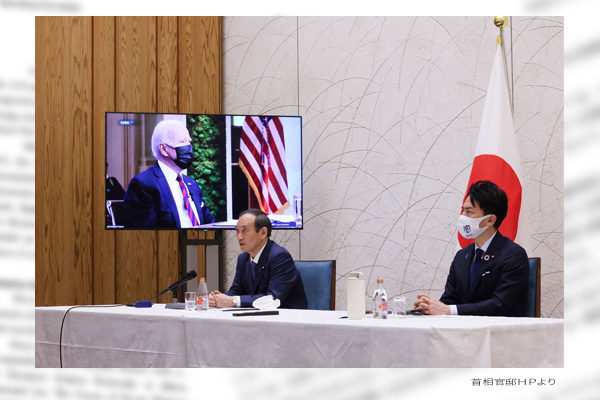Japan will seek to cut greenhouse gas emissions in fiscal 2030 by 46% from fiscal 2013, Prime Minister Yoshihide Suga said just before participating in an online climate change summit on April 22. On April 18, the United States released a joint statement with China following a meeting of senior officials from the two countries, emphasizing that the two countries would participate in international efforts against global warming and make efforts to achieve targets under the Paris Climate Accord. The statement indicated a U.S. strategy to draw China into global warming countermeasures and prevent China as the world’s largest GHG emitter from becoming a sole winner by exporting solar and wind power generation equipment and coal-fired power plants.
Japanese emission cuts’ global impact is limited
China accounts for 28% of global carbon dioxide emissions, followed by 15% for the U.S. Japan’s share is only 3.4%, meaning that a 46% cut by Japan would represent only a 1.6% decline in global emissions.
Rather, Japan could make greater contributions to global CO2 emission cuts by exporting efficient coal-fired power plants that emit 17% less CO2 than conventional ones to developing countries.
Since the March 2011 Fukushima nuclear accident, Japan has implemented a substantial nuclear phaseout policy. Only four out of the 50 nuclear power plants in Japan are now in operation. Some 90 trillion yen from financial resources such as renewable energy power generation promotion surcharge paid by consumers as part of power bills is set to be invested in solar power generation. Japan has installed solar panels with total capacity of 62 gigawatts (equivalent to 62 1-GW nuclear reactors) at the world’s highest density, but CO2 emissions declined only by 4%. This is because actual solar power generation amounts to only 13% of solar panel capacity in Japan where the frequency of sunny days is limited to some 50%, with sunshine available at daytime only. Even if solar panels are required to be installed at all houses in Japan, installation would be difficult for existing houses, with the impact limited.
The government has vowed to place emphasis on wind power generation, but a large wind farm off Fukushima Prefecture has been withdrawn. This is not because the performance of wind mills made by Mitsubishi Heavy Industries Ltd. is poor, but rather because wind resources there is poor. In Japan, strong-wind locations are limited to the Sea of Japan coast of Hokkaido. Wind strength and strong-wind hours even at the location are half the British or Danish levels.
Nuclear power plants hold the key
Both Japan Business Federation Chairman Hiroaki Nakanishi and Japan Chamber of Commerce and Industry Chairman Akio Mimura have asserted that politicians should take strong leadership in restarting existing nuclear power plants and constructing new and additional plants steadily if their safety is reaffirmed. On April 12, the Japan Institute of National Fundamentals also advocated the importance of nuclear power by releasing a policy proposal titled “The Answer to Decarbonization Is Nuclear Power.”
Countries with the lowest CO2 emissions per kilowatt-hour include Norway, Sweden, Switzerland and France that depend heavily on hydro and nuclear energy for power generation. If all nuclear power plants under screening by the Nuclear Regulation Authority are restarted in Japan, CO2 emissions would be cut 20%. If nuclear power plants cover 35% of power demand in Japan in the future, 24 new and additional nuclear plants would have to be constructed and old reactors have to be replaced at the estimated cost of 34 trillion yen. This means that nuclear power plant investment would be far more cost-effective than renewable energy investment.
Tadashi Narabayashi is a specially appointed professor at the Tokyo Institute of Technology and a director at the Japan Institute for National Fundamentals.


